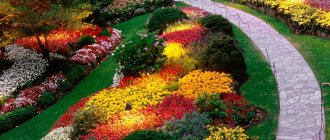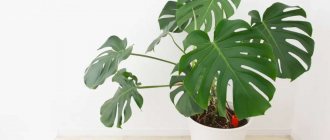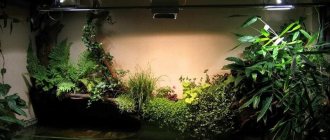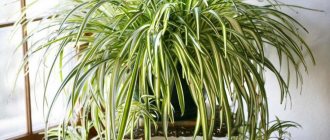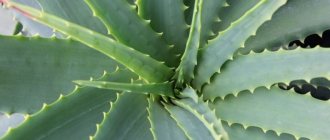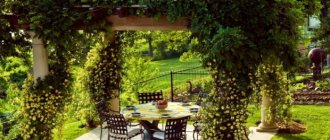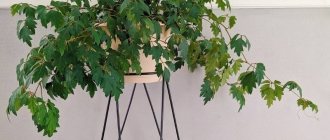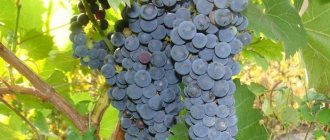Having a greenhouse of indoor plants at home is not only beautiful, it has a beneficial effect on the surrounding atmosphere. After all, plants are able to purify the air by converting carbon dioxide into oxygen. But how to install this “filter” in the house if there is little light and no time at all to create a microclimate? In such a situation, preference should be given to shade-loving and unpretentious subspecies of ornamental plants. They have advantages:
- They provide maximum oxygen in dark places; some species are only able to filter the air at night. Perfect for the bedroom.
- They do not require frequent watering and fertilizing.
- There is no need to create a special microclimate.
There are a large number of subspecies of shade-loving plants, this article will help you make a choice - it will tell you about popular plants, their advantages and disadvantages, and how to avoid mistakes when choosing.
Little flowering, non-flowering
Bordered, Draco
These are varieties of dracaena that are distinguished by their beauty and are not capricious to living conditions. They can be kept in the darkest corners of the apartment.
Dracaena can be found in many offices and institutions, attracted by its exotic appearance and unpretentiousness.
In favorable conditions it can grow up to 5 meters in height. Artificial lighting has a good effect on the development of the plant.
Advantages:
- water no more than once a week;
- transplantation is carried out once a year;
- does not require fertilizing.
Flaw:
- in dark corners it practically does not bloom.
Sansevieria
It is better to start with this species for those who are just trying to make friends with house plants. Sansevieria grows well in any conditions. Tolerates drought or humidity easily. The plant rarely develops color, but if you maintain optimal conditions without changes, you can find flower buds.
Care is simple:
- watering once every 7-9 days;
- Irrigate foliage only in hot weather;
- fertilize the soil once every 6 months;
- transplantation is carried out after growth.
Advantages:
- loves translucent places;
- grows well at temperatures above 14 degrees;
- give maximum oxygen.
Flaws:
- in winter, additional lighting is required;
- doesn't like drafts.
Hibiscus
Everyone's favorite Chinese rose with large beautiful buds. This plant not only serves as home decoration, but is also used in the treatment of many diseases. Hibiscus leaves contain a large list of vitamins.
Advantages:
- fertilize the soil no more than once every 4-5 weeks;
- You can completely eliminate fertilizers, but the plant will not bloom.
Flaws:
- mandatory placement with little access to light;
- moistening the soil once every 7-9 days;
- It is necessary to create a special microclimate.
Fatsia japonica
The plant does not require the creation of certain climatic conditions, loves the darkest corners of the room and even grows well near heating devices. The flower is perfect for the bedroom, as flower growers claim that fatsia has a beneficial effect on sleep.
Advantages:
- humidifies the air;
- low probability of parasites and infection with any disease.
Flaws:
- Not identified.
Geranium
A beautiful flowering house plant that gains color even with infrequent care. It is better to place a flower pot on the east or west side. It is enough to moisten the soil several times every 14 days.
Advantages:
- no special microclimate is required;
- the aroma cures headaches.
Flaw:
- In order for geranium to bloom profusely and for a long time, it is necessary to apply complementary foods once a month.
Aspidistra tall
If you grow this plant only in the shade, then you should purchase aspidistra varieties with a purely green color.
Advantages:
- not demanding on microclimate;
- subcortices are rarely done.
Flaws:
- stagnation of water has a bad effect on the leaves;
- It is important to avoid direct sunlight.
Aglaonema variable
The indoor flower is varied in varieties and colors, from golden to gray shades.
Dense foliage creates a wonderful decoration for the room, unpretentious to the microclimate.
Advantages:
- capable of growing in the darkest corners.
Flaw:
- It is necessary to carefully monitor soil moisture.
What to plant in the shade at the dacha
There are plants that tolerate conditions where sunlight hits the site for a couple of hours. If you follow agricultural technology, even in such conditions it is possible to grow plants and get a harvest.
What flowers to plant in the shade
Low illumination during the day is well tolerated by:
- Badan. Loves moisture, grows in the shade, but does not bloom.
- Day-lily. Grows quickly in the shade and loves moist soil.
- Forget-me-nots. Quickly covering the ground in the shade, simple and unpretentious flowers decorate the garden, alpine hill with their beauty.
- Periwinkle. Planted to quickly cover the ground in the shade of trees or near a fence.
- Loosestrife.
But peonies do not grow well in the shade. These plants love the sun; in extreme cases, partial shade is allowed. Peonies grow in dense shade, but do not bloom.
The queen of shade is the hydrangea. The perennial shrub blooms beautifully in the shade. The plant combines openwork, massiveness and elegance. The bush gives volume, splendor and a bright scattering of flowers.
Video: What flowers can be planted in the shade
Vegetable bed in the shade
Some vegetables can also be grown in full shade. Shade-tolerant plants include:
- cucumbers;
- lettuce;
- chives;
- rhubarb;
- radish;
- beet.
Cauliflower and white cabbage grow well in a little shade. Shaded areas can also be used for growing herbs: parsley, dill, celery, onions, lettuce and sorrel.
What fruit trees to plant in the shade
If there is no more space on the site, except shaded, then it is recommended to plant:
- apple trees;
- viburnum;
- rowan;
- hazel;
- any varieties of honeysuckle.
Plant the same fruit trees in the shade as in partial shade, but pay more attention to the prevention of fungal diseases and parasites.
What to plant in the shade at the dacha from shrubs
Among the berry bushes you can choose for the shady part of the garden plot:
- blackberries,
- raspberry seedlings,
- rose hip,
- gooseberry,
- red currants,
- elderberry
Some are trying to plant empty spaces in the shade with strawberries. However, the berry loves light. The more sun the strawberries receive, the tastier and larger the berries become.
Video: Shade-loving trees and shrubs
Gain color all year round
Among the shade-loving plants, there are plants that are able to constantly gain color in the shade; with the presence of bait, flowering can be abundant. Flowering plants are more demanding on the microclimate. For your reverent attitude towards yourself, they reward you with beautiful flowers that will decorate any corner of the apartment.
Male happiness - anthurium
Atrium is considered to be a male enhancement enhancer. Many people are skeptical about this, but they still grow the flower in their apartment. Requires minimal cost per move.
Advantages:
- loves dark corners of the room, ultraviolet radiation from direct rays is harmful, the sun can damage the leaves. If you still place it near a window, it is better on the east or west side;
- Blooms beautifully without the presence of complementary foods.
Flaws:
- It is advisable to monitor soil moisture; the soil should not be dry;
- Regular complementary feeding will ensure continuous flowering.
Pelargonium
A popular flower among lovers of indoor floriculture. The plant can be placed in any corner of the room; in the shade the flower will stretch in height, and in the sun it will grow in breadth.
Advantages:
- gains color all year round and constantly.
Flaws:
- it is necessary to constantly maintain soil moisture;
- If you want to grow a neat bush, you should constantly trim off the faded buds.
Begonia royal
This variety of begonia is suitable for those who plan to have flowering, unpretentious house plants. The flower is not sensitive to its location; it only needs a little ultraviolet light to bloom.
There are a large variety of begonia varieties, but flower growers prefer decorative royal begonia, since the lack of flowering is compensated by the presence of gorgeous leaves of various colors.
Advantages:
- Gorgeous appearance even without flowering.
Flaws:
- loves abundant watering, but at the same time not allowing moisture to stagnate in the pot;
- Trim the roots in time, as begonia can grow profusely and take a long time to gain color.
Spathiphyllum
This indoor flower will appeal to those who love feces. The plant produces white flowers consisting of one petal. It is worth placing the flower in places where the sun's rays will not fall on the leaves. Due to direct contact, the foliage quickly turns yellow.
Advantage:
- flowering all year round is more intense in the summer.
Flaw:
- You will have to constantly monitor soil moisture, otherwise flowering will disappear.
Kalanchoe
A flowering plant that loves summer. It is advisable to place it in a semi-shaded place. Will decorate with flowering all year round.
Advantage:
- You don’t have to think about Kalanchoe for a month; even in dry soil it grows well.
Flaws:
- When forming seeds, the plant literally shoots them all around, which forces you to frequently tidy up around the plant.
Chlorophytum
A hanging plant with drooping shoots. Perfectly decorate a wall in a room with poor light transmission. Resistant to changes in microclimate in the apartment.
Advantage:
- the root system is designed in such a way that it takes in water gradually, and within two weeks the flower does not need watering;
- does not require the creation of special microclimate conditions.
Flaw:
- To prevent the foliage of chlorophytum from drying out quickly, spraying should be carried out constantly.
Alocasia
The plant can germinate perfectly in the darkest corner of the apartment and still produce flowers. However, for the plant to exist comfortably in the shade, painstaking work is required.
- First, it is planted in a special mixture, the ingredients of which resemble soil for growing orchids;
- There should always be moisture in the soil. Therefore, a strict watering schedule is developed.
Advantage:
- absolutely does not require light;
- It can even bloom.
Flaw:
- demanding on watering.
Epipremnum
If you need to decorate the interior of an apartment with insufficient lighting, you should purchase epipremnum. This climbing plant will perfectly decorate the room and does not require any costs to care for. Withstands various microclimatic conditions. Grows up to 3 meters.
Advantages:
- soil moisture is rare;
- does not require feeding.
Flaws:
- in the complete absence of light, the foliage loses its mottled appearance, but the decorative effect is preserved.
Low-growing perennials
Plants of this group do not exceed 30-50 cm in height. Among them, it is easiest to choose shade-loving flowers for the flowerbed that bloom beautifully in spring and summer.
Spring bulbs (galanthus, crocus, muscari, scilla), liverwort , primrose , corydalis , lily of the valley will decorate shady places immediately after the snow melts, and the trunk circles of still bare trees will bloom.
Noble liverwort
The well-known “blue snowdrop” or “copse” grows in forests, bushes along the edges of forest edges, along the banks of ravines and streams. Belongs to winter-green plants: the characteristic three-lobed leaves remain under snow cover until spring.
Many people grow it as a garden crop. So, more than ten years ago, I brought the liverwort from the forest, dug it up with a clod of earth, and planted it in the front garden of my parents’ house under a cherry tree. The place is illuminated only until lunch, the rest of the time it is in shadow. The seedlings have successfully adapted and still bloom every year.
The liverwort belongs to the Ranunculaceae family, and owes its name to the similarity of the shape of the leaves to the liver
Fragrant violets , violas , and daisies that bloom at the beginning of summer grow well in the light, but planting in the shade benefits them: they will bloom longer and retain their decorative properties.
The community of low shady perennials also includes gravilat , heuchera , and decorative deciduous low-growing varieties of hosta .
Heuchera
Popularity (slightly inferior to hosta), ease of care, durability, decorativeness and a rich color palette of leaf shades - all this is about heuchera, a representative of the Saxifraga family. It is valued for the beauty of its leaves, which can change color during the growing season. Propagated by dividing the bush, green cuttings, and seeds. Shade and places with diffused lighting are suitable for planting.
Heuchera blood-red and many hybrids bred on its basis are long-flowering - flowering continues until late autumn.
Heuchera blood-red reaches 25 cm, and peduncles with red, pink, crimson flowers stretch up to half a meter
Indoor large sizes. Palm trees
You can diversify your interior or add a touch of exoticism to your home atmosphere with the help of decorative palm trees or large trees. However, in most cases this is a costly affair and requires painstaking work to create special climatic conditions for the germination of exotic plants at home. Large-sized and indoor palms do not tolerate frequent transplants and drafts. For those who do not have the time to look after and provide proper care for such plants, it is recommended to purchase unpretentious varieties. There are several of the most popular types.
Hamedorea
The plant takes root in any home climatic conditions, does not require excess light and other factors, since it can grow in the proposed conditions.
Advantages:
- no need to think about transplantation, it is necessary no more than once every 1-1.5 years.
Flaw:
- In order for the palm tree to gain growth, intensive watering is required at a certain growth phase.
Howea Forster
Externally, it has larger leaves and stems than chamedoria.
Advantages:
- unpretentious;
- can withstand drought.
Flaw:
- if growth is needed, then the howea must be irrigated and fed constantly.
Dangerous house flowers
Some types of flowers can release toxic substances to pets and can also be dangerous to people. Despite the warnings, many people safely keep such plants at home.
- Philodendron (dangerous for cats; if an adult or child eats a piece of the plant, minor side effects will occur);
- Syngonium (causes vomiting in humans and animals if a piece is eaten);
- Spathiphyllum (the most dangerous type of flower, if it gets into the stomach it causes serious consequences);
- Dieffenbachia (causes mild symptoms of poisoning).
Indifferent to conditions
These are universal soldiers who don’t care about anything.
Euphorbiaceae
They are diverse, original, and have medicinal properties. Most are poisonous, so they need to be replanted very carefully.
Soil: any.
Watering: as the soil dries.
Temperature: 6-21 degrees.
Herbaceous
A huge family, among which stand out:
- chlorophytum;
- Golden mustache;
- tradescantia;
- Cyperus;
- Oxalis (Oxalis).
Soil: any. Watering: as the soil dries + spray if desired. Temperature: 7-30.
Plants of this family, which resemble ordinary grass, attract domestic animals and are often harmed by them. In this case, it is better to exclude Cyperus, because its leaves are hard and sharp. The rest will not harm the pet.
Oxalis tends to rest in winter - during this time, simply move the empty pot from the window and water it 1-2 times a month.
Fashionable shade-loving plants: how much does it cost to buy?
Houseplants that love shade can be purchased at any specialty store. In terms of price, there are both inexpensive varieties and those whose average price is not affordable for everyone. Among the most popular types of shade-loving flowers are:
- Hamedorea
indoor palm tree with feathery leaves. Unpretentious in care, the only thing that needs to be observed is the thermal regime. Price: in the aisles 300 rubles.
Advantage:
- If you plant several palm trees together, you will get dense thickets.
Flaw:
- You will have to constantly spray the foliage.
- Aucuba japonica
A beautiful plant with gold flecks on the foliage. Price: in the aisles 400 rubles.
Advantages:
- Does not require the creation of climatic conditions;
- Rare watering is possible.
Flaw:
- all parts of the plant are poisonous.
- Philodendron
A type of vine that grows up to two meters in length. Will perfectly decorate the interior of any apartment. Easy to care for. Budget varieties can be purchased for only 100 rubles.
Advantages:
- This plant will adapt to any conditions.
Flaws:
- No.
- Epipremnum pinnate
More often found as a plant with lush foliage. The most popular flower among gardeners. Price: 250 rubles.
Advantages:
- tolerates dry air well;
- perfectly purifies indoor air from germs.
Flaws:
- requires fertilizing and watering control.
Sansevieria
Another name is mother-in-law's tongue or pike tail. The plant received this name because of the shape of the leaves - long, large, erect, with light veins. This is a popular type that can be found in schools, hospitals, and offices. There are many types of sansevieria, so choose an unusual one for your home, for example, with wide oval leaves collected in a rosette.
For all types of sansevieria, care will be equally simple. Room temperature and diffused light suit her. Water as the soil dries out. A godsend for forgetful flower growers - the flower will even survive repeated drying out. Pike tail can grow up to 1 meter in height, so place it on the floor immediately.
How to choose a plant
To buy a flower that is necessary for specific living conditions, you should adhere to certain points.
What to look for when choosing:
- remember that if unpretentious plants are the object of choice, they should still be cared for, even minimally;
- You should only purchase plants in special stores; the consultant will give a full description and tell you how to care for the flower;
- clearly understand where you want to place the flower pot;
- When purchasing, pay attention to the general condition of the plant; it should be rich in color, without dry leaves or signs of disease;
- The soil condition should not be dry or too wet.
Safety for plants
All types of houseplants are prone to disease or pest damage. Some to a greater extent, some to a lesser extent.
It is necessary to carry out preventive measures:
- You should carefully examine the leaves of the flower from the outside and inside. This must be done upon purchase, and also inspect the plants in the apartment once a week.
- When planting, the container for the plant and bud must be heated or frozen, depending on the selected species.
- You need to know how to create a microclimate for flowers that are at risk.
If parasites are detected:
- Immediately isolate the plant from others, as pests spread very quickly;
- Collect pests by hand or rinse with a strong stream of water (repeat several times in a row);
- Wipe the leaves with a stiff brush dipped in soapy water.
- To combat persistent pests, use a soft cloth to wipe the leaves with a solution of alcohol or denatured alcohol;
- You can wipe the leaves with a decoction of garlic, hot pepper or onion for a month;
- It is not recommended to carry out chemical-based treatment at home, however, if there are a large number of pests, then you can use Fitoverm. It effectively fights many types of pests, while being absolutely safe for humans and pets.
Which house plant to choose?
From the description of the most popular types of shade-tolerant plants, we can conclude that if you need a flower that you don’t have time to care for, then you should choose unpretentious, low-flowering plants. If you are able to provide careful care, then flowering plants will delight you all year round.
Where is the best place to install the plant?
For a children's room, it is better to purchase sansevieria and all similar types of indoor plants. Their advantages are that they perfectly purify the air and do not require frequent wet cleaning of leaves. Also suitable for children is chlorophytum, which absorbs harmful substances from the air.
For the bedroom, it is better to choose Japanese fatsia, since in the dark it produces oxygen more actively and perfectly humidifies the air.
In the kitchen it is worth placing plants that require a small amount of light. Popular blooming flowers for the kitchen are begonias. Its leaves release essential oils, thanks to which it disinfects the air in the room.
You can place plants in the corridor that thrive in the darkest corners. Curly shade-loving flowers are suitable for decorating the corridor, the most popular are:
- Chlorophytum;
- Epipremnum;
- Tradescantia.
Choosing the right plant will allow you to decorate a space even where access to natural light is completely excluded. It is important to follow the rules for caring for the chosen flowers.
general characteristics
Contrary to the prevailing stereotype, the range of shade-tolerant plants for the garden is not so small: photos and names indicate a wealth of choice for a keen gardener. Many varieties are unpretentious and will delight even novice and busy gardeners.
It is customary to distinguish two groups of plants:
- shade-loving - not suitable for sunny areas;
- shade-tolerant - tolerate both shading and full lighting.
Each culture is individual in its preference for shade or partial shade, shade for several hours a day or constantly. When choosing, you should also take into account the traditional division of plants into annuals and perennials. Annuals provide a quick decorative effect, while perennials work well for the future.
In general, most of the species presented below can grow in shade and partial shade.
Bulbous and tuberous plants for partial shade
Snowdrops
Snowdrop bushes are low, they are decorated with small hanging white flowers. This shade-loving plant blooms in March. Its flowers are among the first to open in the garden in spring. The culture is highly frost-resistant.
Dodecatheon vulgaris
The tuber culture Dodecatheon vulgaris can be rarely seen in gardens of mid-latitudes. The bushes bloom very beautifully and are highly resistant to frost. The crop can be grown in a semi-shaded place. It is recommended to plant it with other perennial plants, since when the bush fades, it withers.
Corydalis
The corydalis plant is part of the Dymyankaceae subfamily. This herbaceous crop is medium or low growing. Regions with a temperate climate are suitable for its cultivation. In May, the bushes are decorated with flowers of blue, white, pink and purple colors.
Checkered hazel grouse
The herbaceous perennial plant checkerboard fritillary is decorated with spectacular drooping flowers, the petals of which are decorated with an unusual pockmarked pattern. Moist and shady areas of spring flower beds and rockeries are suitable for its cultivation; the flower can also be planted on the lawn in the garden or under bushes.
15 FLOWERING PERENNIALS FOR SHADOW / SHADY GARDEN FAVORITES
Ferns
Ferns can grow in the shade and should be provided with moderately moist soil.
The most popular ferns in gardens are:
- Scutellum male;
- Common centipede;
- Grenadier Grenadier;
- Common ostrich;
- Polyriza spinosa.
Shade-loving perennial shrubs
Common wolfberry
Wolfberry should grow in a shady place. The flowering of this shrub is lush and early. The flowers are painted white or pink. The fruits appear from June to July.
Please note that the fruits of such a plant contain strong poison. That is why one of the names of such a shrub is deadly wolfberry. Under no circumstances should you plant it in areas where children are.
Hydrangea
Hydrangea is a beautiful flowering shrub. It can be grown in shaded areas, but in such conditions the flowering of the bush becomes more sparse. Hydrangea paniculata is best suited for growing in shady areas.
Rhododendrons
Shade-tolerant rhododendron grows well in shady and semi-shaded places. It is better to choose a secluded place with protection from the wind. This beautifully flowering shrub pleases with its flowers from May to early June. The best soil is sandy-humus, loose and moderately moist. It should also be sour.
Holly holly
Holly holly is an ornamental shrub that belongs to the Holly family. It can be grown in a shady place under tall trees. Secluded areas with protection from the wind are best suited for its cultivation. You should also take into account that sudden temperature fluctuations can harm the plant. Bright sunlight at midday can leave burns on the foliage.
Holly is decorated with spherical fruits that look impressive against the background of dark green leaves. They do not fly off the branches throughout the winter. At the same time, severe frosts can destroy the holly.
Fuchsia
The perennial fuchsia shrub is native to America. In mid-latitudes it is cultivated as an annual, as it is characterized by low frost resistance. In the summer, fuchsia can be planted in open ground, and an area located in partial shade or shade is chosen for it. The plant does not do well in sunny areas.
Such a crop requires systematic feeding, and it is also necessary to ensure optimal soil moisture. The shrub pleases with its flowering throughout the summer-autumn period. For wintering, the bush is brought into a cool room.
Plants for coastal areas with high humidity
The following plants are most often grown in shady coastal areas with high humidity:
- buzulnik;
- marsh marigold;
- loosestrife;
- point loosestrife;
- ivy;
- astilbe;
- hellebore;
- Siberian iris, Japanese, common yellow;
- European swimsuit;
- Tradescantia virginiana, Anderson.


